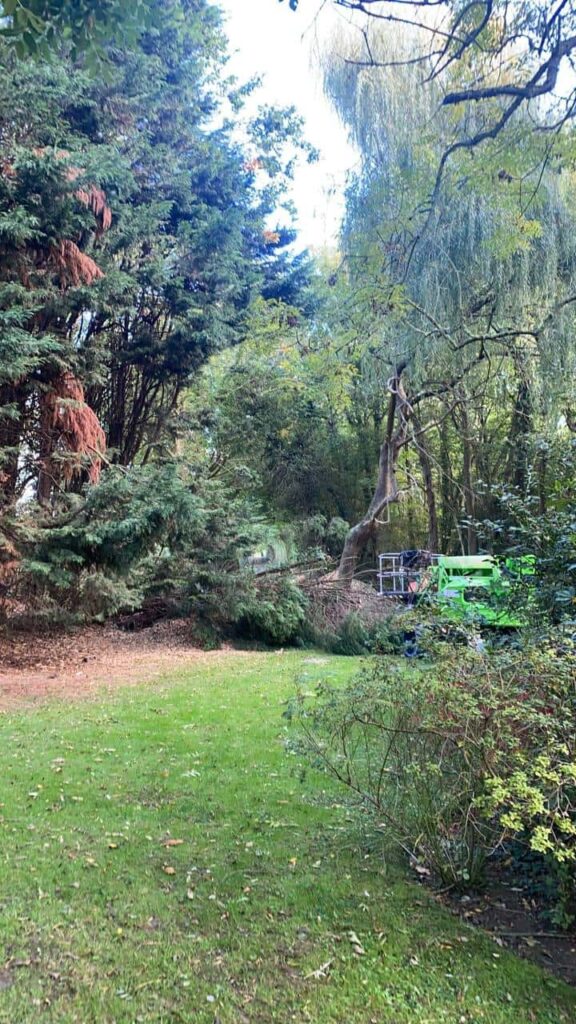Trees play a vital role in creating attractive, healthy outdoor spaces, but when a large tree begins to lean, it can quickly become a significant safety concern. While not every leaning tree is dangerous, a noticeable or worsening lean—especially in a mature or heavy tree—can indicate structural instability. In many cases, urgent removal is the safest and most responsible option. For homeowners in Bury St Edmunds, Suffolk, recognising when a leaning tree is becoming hazardous is essential for protecting people, property, and neighbouring land. Bury St Edmunds Tree Surgeons explains why large leaning trees require immediate attention and removal.
A Leaning Tree Is Often a Sign of Serious Structural Problems
A mature tree does not begin to lean without reason. Most leaning occurs only when structural integrity has been compromised or when environmental factors have weakened the tree.
Root Damage or Root Failure
A tree’s roots anchor it firmly in the ground. If the roots are damaged by disease, excavation, soil erosion, or restricted growth, they may fail to support the tree’s weight. A leaning trunk is often the first visible sign.
Storm or Weather Impact
Strong winds, heavy rain, saturated soil, and previous storms can loosen a tree’s anchoring points. Once the ground shifts, the tree may tilt unexpectedly.
Weak or Decayed Trunk
Internal decay caused by fungi, pests, or age significantly reduces the tree’s structural strength. Even if the tree appears healthy from the outside, internal issues can cause one-sided leaning.
Uneven Growth or Poor Structure
Some trees develop an imbalanced canopy, placing too much weight on one side. Over time, the tree compensates by tilting in the heavier direction, increasing the risk of collapse.
These conditions can develop slowly or suddenly, but once the lean becomes visible, the danger often escalates quickly.
Why Large Leaning Trees Are Especially Dangerous
The bigger the tree, the greater the risk. Large, heavy trees with a visible lean can cause severe damage if they fail.
Higher Risk of Falling Without Warning
A weakened tree may fall unexpectedly, even in calm weather. When a large tree loses its remaining support, it can collapse rapidly with little time to react.
Significant Damage to Homes and Outbuildings
A large tree falling onto roofs, garages, sheds, or parked vehicles can cause extensive structural damage.
Threat to People and Pets
Leaning trees can drop limbs or collapse entirely, creating a serious hazard for anyone nearby.
Risk to Neighbouring Properties
Leaning trees located near boundary lines or close to other buildings can affect more than just your own property.
Potential Obstruction of Roads and Access Routes
If the tree falls across a driveway, footpath, or road, it can block access and create hazards for others.
Because of these risks, urgent removal is often the safest course of action for large leaning trees.
Signs a Leaning Tree Needs Immediate Removal
Not all leaning trees are dangerous, but certain warning signs should never be ignored. Bury St Edmunds Tree Surgeons recommends urgent removal if you notice:
A Sudden or Increasing Lean
Rapid changes often indicate that the tree’s structural support is failing.
Cracks in the Soil Around the Base
This shows the root plate may be lifting, suggesting imminent collapse.
Exposed or Damaged Roots
Visible roots that appear snapped, decayed, or weakened can no longer anchor the tree safely.
Cracks or Splits in the Trunk
These are signs of severe internal stress and instability.
Dead or Dying Branches on the Leaning Side
Uneven health can indicate deeper structural problems in the tree.
The Lean Faces a Home, Road, or High-Traffic Area
If the tree is angled towards a place where damage or injury is more likely, immediate action is required.
Professional tree surgeons should be contacted as soon as any of these signs appear.
Why Professional Removal Is Essential for Leaning Trees
Removing a leaning tree is far more complex and dangerous than standard tree felling. The imbalance of weight, unpredictable movement, and risk of sudden failure make professional expertise essential.
Specialist Knowledge
Professionals understand how weight distribution affects the direction of fall and how to dismantle the tree safely in sections.
Use of Correct Equipment
Ropes, harnesses, rigging systems, and protective gear are required to remove a leaning tree without uncontrolled collapse.
Protection of Surrounding Areas
Controlled removal prevents damage to gardens, fencing, buildings, and neighbouring properties.
Safe Management of All Debris
Once removed, the tree must be processed and cleared efficiently, especially if large sections need lifting or cutting.
Bury St Edmunds Tree Surgeons has the experience and equipment needed to carry out complex removals safely and efficiently.
Leaning Trees in Bury St Edmunds Need Rapid Attention
Bury St Edmunds, Suffolk experiences varied weather conditions, including strong winds and saturated soils during wet seasons. These conditions increase the risk of leaning trees becoming unstable. Local soil types and mature tree populations also contribute to structural weakening, making it essential for homeowners to act quickly when problems arise.
Conclusion
Large leaning trees create immediate safety risks and should never be ignored. Whether caused by damaged roots, unstable soil, internal decay, or storm impact, a leaning tree can fall without warning and lead to serious damage or injury. Professional assessment and urgent removal from Bury St Edmunds Tree Surgeons ensures your property remains safe, protected, and well maintained.
Call us on: 01284 339 498
Click here to find out more about Bury St Edmunds Tree Surgeons
Click here to complete our contact form and see how we can help with your tree needs.

